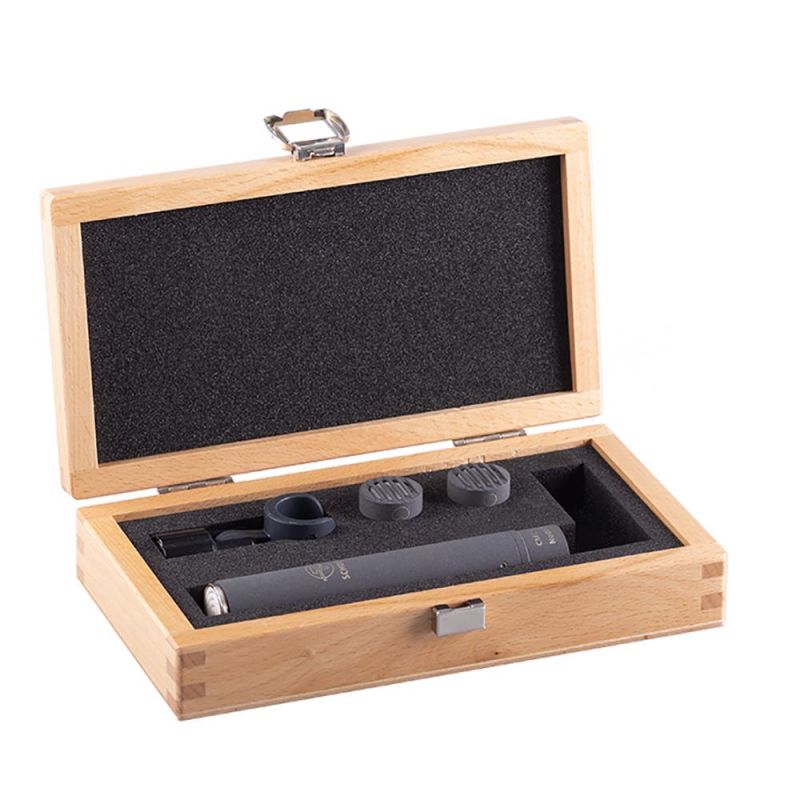Schoeps Flexi-set with CMC 6, MK 4 and MK 22 Capsules
Schoeps Flexi-Set of CMC 6 preamplifier with both MK 4 Cardioid and MK 22 Open Cardioid Capsules giving you a great range of flexible use at a bundled discounted price
Schoeps Flexi-Set with CMC 6, MK 4 and MK 22 Capsules
- CMC 6 microphone amplifier
- MK 4 capsule with cardioid pattern
- MK 22 capsule with open-cardioid pattern
- Use as part of stereo recording with coincident or ORTF microphone arrangements
- Ideal as a spot mic
- flat frequency response
- very low harmonic distortion and noise
- works with 12V and 48V phantom power
- balanced, low-impedance output
- excellent protection against high-frequency radio interference with "RFI Shield"
- frequency-independent impedance
- signal transmission possible over very long cables
- reliable operation even with weak phantom power
- symmetrical, transformer- and capacitor-free output stage with a class-A amplifier
- above 20 kHz, the signal is attenuated for protection against interference in the ultrasonic range, e.g. through the ultrasonic autofocus of a film camera
- 2yr Schoeps Warranty but extended to 10yrs if product is registered with Schoeps
Included in the Box
- 1 x Schoeps CMC 6
- 1 x Schoeps MK 4 Cardioid Capsule
- 1 x Schoeps MK 22 Open Cardioid Capsule
- 1 x Schoeps SG 20 Stand Mount
- 1 x Case
Schoeps Flexi-Set with CMC 6, MK 4 and MK 22 Capsules
The CMC 6 Microphone Pre-amplifier
The capsules of condenser microphones can't be connected directly to microphone cables or inputs; a microphone amplifier is required in between. Thus a complete microphone of the Colette series comprises any of the twenty available types of capsules combined with an amplifier. The CMC 6 U is designed for standard 48- and 12-Volt phantom powering. Its circuitry recognizes the supply voltage and adjusts itself automatically. Its performance characteristics remain essentially the same either way; mainly, the difference is that the current drawn at 12 Volts is greater than at 48 Volts. However, the 12-Volt mode consumes less power and might be preferred for battery-powered recording.
The microphone amplifier is responsible for providing the necessary electric charge to the capsule, without which it would be unable to generate a signal. Since the capsule's output signal is very weak (Hi-Z), it must be amplified. In order for the microphone's output to cleanly reach the next stage in the signal chain, it must undergo balancing and impedance matching before transmission. The CMC 6 incorporates a balanced, direct-coupled class-A amplifier, yielding a low output impedance, high RF shielding, and minimal distortion.
The MK 4 Cardioid Capsule
The MK 4 has been a reference microphone for years in a wide variety of recording situations.
Due to its transparent sound character and excellent attenuation of rear-incident sound, it reproduces sound sources very naturally. This has given the MK 4 a reputation as a universal "problem solver" even in difficult recording situations.
Its flat frequency response, and the constancy of its directional pattern for all frequencies, are the basis of the MK 4’s sound quality. Even in the diffuse sound field its frequency response is flat, with a slight increase at 10 kHz compensating for high-frequency losses in the room.
Thus the sound image is transparent for direct-arriving sound, for sound arriving from the side, and for diffuse sound in the room (reverberation).
The MK 4 is a classic small-diaphragm microphone with all the advantages of this microphone type. Its frequency response and the consistency of its polar diagram from low to high frequencies are exemplary.
Like all SCHOEPS capsules, the MK 4 achieves its flat frequency response solely by its mechanical architecture, without any electronic filtering.
As a pressure gradient transducer, the MK 4 has a single diaphragm that is exposed to the sound from both the front and rear. The side sound inlets must therefore never be covered.
The “reach” (distance factor) of a classic cardioid such as the MK 4 is about 1.7 times that of an omnidirectional microphone. Thus even at greater distances from the sound source, direct sound can be obtained. The advantages of the MK 4 are shown especially when mixing several microphone signals - pickup of sound from the side is reduced in level but not subject to coloration.
At 90° the attenuation of the MK 4 is 6 dB, and at 180°, some 20 to 30 dB. Diffuse-incident sound is picked up 4.8 dB lower in level than front-arriving sound.
The MK 22 Open-Cardioid Capsule
The "Open Cardioid" pickup pattern was introduced by SCHOEPS in 2008. It lies between the classic cardioid and the wide cardioid, achieving both a fair amount of directivity and very natural sound quality. Many years' experience of professional recording engineers with the range of Schoeps cardioids has played a large role in the development process.
Meanwhile the MK 22 has become a preferred soloist and spot microphone, thus becoming an alternative to the "classic" MK 4.
| Delivery Time | Usually shipped in 2-3 days |
|---|---|
| Price | £1,663.36 |
| Brand | Schoeps |
| Strapline | Schoeps Flexi-Set of CMC 6 preamplifier with both MK 4 Cardioid and MK 22 Open Cardioid Capsules giving you a great range of flexible use at a bundled discounted price |

